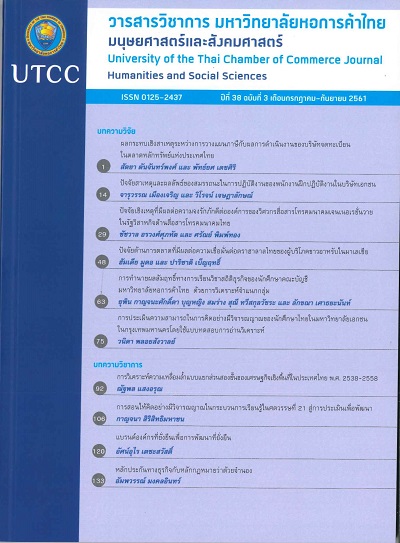Prediction of Learning Achievement on Business Statistics Course of the Accounting Students at the University of the Thai Chamber of Commerce Using Discriminant Analysis
Main Article Content
Abstract
This research aims at predicting learning achievements on business statistics course using discriminant analysis and based on non-intellectual variables to classify students into two groups: low-achievement and high-achievement students. 269 accounting students at the University of the Thai Chamber of Commerce were chosen as the subjects of this study. All of the students took the business statistics course in the first semester of the academic year 2016. The questionnaire was used to elicit the data, and it comprises five parts as follows: a) bio-social data and general information of the students; b) attitudes of the students towards learning and contents; c) teaching behaviors; d) learning behaviors of the students; and e) personal behaviors of the students. Results include that attitudes of the students towards the business statistics subject (X2) and towards the subject content (X3) can discriminate students of low and high requirementgroups at the accuracy rate of 60.6 percent. The derived discriminant equation in raw scores is:Y = - 2.841 + 3.202 X2– 2.195 X3. The results indicate that instructors should try to find a way toimprove the attitude of the students towards business statistics and show how to apply statistics to solve real-world problems to increase learning achievements of the students.
Article Details
ลิขสิทธิ์ของบทความ
ผลงานที่ได้รับการตีพิมพ์ถือเป็นลิขสิทธิ์ของมหาวิทยาลัยหอการค้าไทย ห้ามมิให้นำเนื้อหา ทัศนะ หรือข้อคิดเห็นใด ๆ ของผลงานไปทำซ้ำ ดัดแปลง หรือเผยแพร่ ไม่ว่าทั้งหมดหรือบางส่วนโดยไม่ได้รับอนุญาตเป็นลายลักษณ์อักษรจากมหาวิทยาลัยหอการค้าไทยก่อน
References
Concept and theory about learning achievement. (n.d.). Retrieved February 8, 2017, from https://www.nana-bio.com/Research/image%20research/research%20work/Achievement02/Achievement202.html (in Thai).
Kammark, K. (2015). Factors affecting learning achievement of undergraduate students in calculus 1. Suranaree Journal of Social Science, 9(1), 83-94. (in Thai).
Naksuwan, P., and Saithanu, K. (2012). Prediction of learning achievement on eementary statistics course of Burapha University undergraduate students by discriminant analysis and neural networks. Burapha Science Journal, 17(1), 59-68. (in Thai).
Pukahuta, P. (2015). Factors influencing the academic achievement of students attending Rajamangala University of Technology Isan. University of the Thai Chamber of Commerce Journal, 35(3), 57-67. (in Thai).
Saenarat, S. (2010). Dicrimination by discriminant analysis technique. Retrieved February 8, 2014, from https://rci2010.files.wordpress.com/2010/06/e0b881e0b8b2e0b8a3e0b888e0b8b3e0b981e0b899e0b881e0b881e0b8a5e0b8b8e0b988e0b8a1.pdf (in Thai).
Saothayanun, L., Kanjanasakda, Y., and Taweesakulvatchara, S. (2009). A study of factors affecting the achievement of science students enrolled in the course SG002 mathematics and statistics in everyday life academic year 2007 at the University of the Thai Chamber of Commerce. In Proceeding of national conference UTCC academic week, January 12-16, 2009 (pp. 292-306). Bangkok, Thailand: University of the Thai Chamber of Commerce. (in Thai).
Supadit, T. (2013). Factors affecting learning achievement of graduate students at National Institute of Development Administration academic year 2013. Retrieved February 8, 2017, from https://www.nida.ac.th/th/download/publication/NIDA-research-2.pdf (in Thai).
Taweesakulvatchara, S., Kanjanasakda, Y., Somrang, B., and Saothayanun, L. (2014). A discriminant analysis of factors influencing academic achievement in business statistics course of the business students at the University of the Thai Chamber of Commerce. In Proceeding of the 2nd academic ccience and technology conference (pp. 129-133). Pathum Thani, Thailand: Rungsit University. (in Thai).
Vanichbuncha, G. (2011). Advanced statistical analysis with SPSS for Windows. Bangkok, Thailand: Thummasan. (in Thai).


